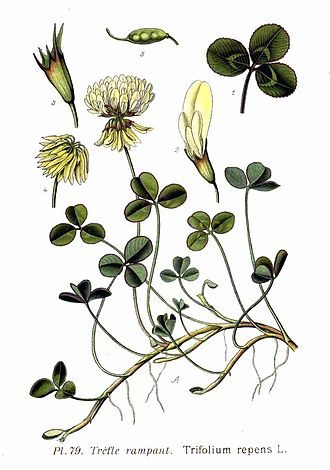Clover

Clover or trefoil are common names for plants of the genus Trifolium (Latin, tres “three” + folium “leaf”), consisting of about 300 species of flowering plants in the legume or pea family Fabaceae originating in Europe. The genus has a cosmopolitan distribution with highest diversity in the temperate Northern Hemisphere, but many species also occur in South America and Africa, including at high altitudes on mountains in the tropics. They are small annual, biennial, or short-lived perennial herbaceous plants, typically growing up to 30 cm tall. The clover is the color of evergreen. The leaves are trifoliate (rarely quatrefoiled; see four-leaf clover), cinquefoil, or septfoil, with stipules adnate to the leaf-stalk, and heads or dense spikes of small red, purple, white, or yellow flowers; the small, few-seeded pods are enclosed in the calyx.[3] Other closely related genera often called clovers include Melilotus (sweet clover) and Medicago (alfalfa or Calvary clover).
Several species of clover are extensively cultivated as fodder plants. The most widely cultivated clovers are white clover, Trifolium repens, and red clover, Trifolium pratense. Clover, either sown alone or in mixture with ryegrass, has for a long time formed a staple crop for silaging, for several reasons: it grows freely, shooting up again after repeated mowings; it produces an abundant crop; it is palatable to and nutritious for livestock; it fixes nitrogen, reducing the need for synthetic fertilizers; it grows in a great range of soils and climates; and it is appropriate for either pasturage or green composting.[3]
In many areas, particularly on acidic soil, clover is short-lived because of a combination of insect pests, diseases and nutrient balance; this is known as “clover sickness”. When crop rotations are managed so that clover does not recur at intervals shorter than eight years, it grows with much of its pristine vigor.[3]
Clovers are most efficiently pollinated by bumblebees, which have declined as a result of agricultural intensification.[4] Honeybees can also pollinate clover, and beekeepers are often in heavy demand from farmers with clover pastures. Farmers reap the benefits of increased reseeding that occurs with increased bee activity, which means that future clover yields remain abundant. Beekeepers benefit from the clover bloom, as clover is one of the main nectar sources for honeybees.[citation needed]
Colorful flowers of clovers beside Zarivar Lake in Iran
White clover
Trifolium repens, white or Dutch clover, is a perennial abundant in meadows and good pastures. The flowers are white or pinkish, becoming brown and deflexed as the corolla fades. Trifolium hybridum, alsike or Swedish clover, is a perennial which was introduced early in the 19th century and has now become naturalized in Britain. The flowers are white or rosy, and resemble those of Trifolium repens. Trifolium medium, meadow or zigzag clover, a perennial with straggling flexuous stems and rose-purple flowers,[3] has potential for interbreeding with T. pratense to produce perennial crop plants.[5]
Other species are: Trifolium arvense, hare’s-foot trefoil; found in fields and dry pastures, a soft hairy plant with minute white or pale pink flowers and feathery sepals; Trifolium fragiferum, strawberry clover, with globose, rose-purple heads and swollen calyxes; Trifolium campestre, hop trefoil, on dry pastures and roadsides, the heads of pale yellow flowers suggesting miniature hops; and the somewhat similar Trifolium dubium, common in pastures and roadsides, with smaller heads and small yellow flowers turning dark brown.[3]
